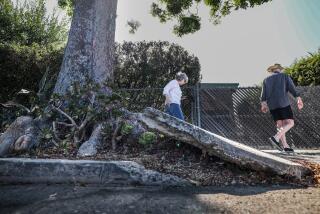To make room for cyclists, L.A. tries a road diet
- Share via
Motor Avenue in Los Angeles went on a “road diet.” I certainly didn’t think it needed to slim down. Twice a week I zipped from Palms Boulevard to Venice Boulevard, using either of the two southbound lanes on Motor to pass cars and get to my Pilates studio faster. When you’re slogging through early evening rush-hour traffic trying to arrive on time at an exercise session you’ve already paid dearly for, speed is of the essence.
So I was surprised one night to discover that Motor had lost a lane of traffic. Construction? Some odd and temporary road work? Oh, no. It had lost a lane of traffic to a dedicated bike lane, its outlines resplendent in new white paint.
What a ridiculous idea, I thought. Had anyone ever seen a bicycle on Motor? Instead, I was relegated to one often-crowded lane of traffic trudging down the street -- next to the empty bike lane.
FULL COVERAGE: Sharing the road in L.A.
OK, so it’s just a few blocks, but it was still frustrating. I was tempted more than a few times to simply veer out of the traffic and drive in the bike lane. But I didn’t. Nor did anyone else.
After a couple of weeks of being angry, I remembered something. I’m the person who wrote -- on this blog -- that the city’s philosophy about putting drivers and bicyclists together on fast-paced Los Angeles roads relied on a kind of magical realism: “You bicyclists and drivers -- just share the road and figure it out yourselves!” That doesn’t work very well for anyone, I wrote.
Now, on Motor, it struck me that the city was doing exactly what I wanted it to do -- make a specific plan for how to mix 2,000-pound cars with eight-pound bicycles. Yes, I lost a lane of traffic, but I got some clarity about where exactly cyclists and drivers should be on that street.
I had adjusted to the new reality of my slimmed-down street, which is pretty much what L.A. transportation officials want you to do. When bike lanes are installed on streets, it automatically “calms” traffic, if not the drivers. Although, as with other calming features -- rotaries and speed bumps, for example -- the drivers who can’t deal with the slow pace avoid those streets altogether and go elsewhere.
That’s exactly what transportation officials want you to do: either slow down or find another street. In the case of the densely populated neighborhood around Motor Avenue, which has stores, restaurants, apartment buildings, my Pilates studio, a post office, the community wanted the traffic slowed more than it wanted a bike lane.
“Motor has been a cut-through street, and it’s very fast. It’s been difficult for the neighborhood,” said Michelle Mowery, senior bicycle coordinator for the city’s Department of Transportation. “Businesses lobbied for the bike lane to slow down traffic. The City Council office was lobbied. We didn’t just do it.”
Other streets have gone on road diets, losing lanes of traffic to bike lanes. It’s worked successfully, Mowery says, on 7th Street from downtown to the site of the former Ambassador Hotel. “That we did for bicyclists,” she said.
There will be more dieting to come. But drivers need not worry that the city will do this on every major street. That would just starve us all.
ALSO:
Michelle Mowery, L.A.’s bike czar, talks to drivers too
Another thing to admire about Janet Yellen: Her hair!
Miley Cyrus syndrome: Where have all the grown-ups gone?
This post is part of an ongoing conversation to explore how the city’s cyclists, drivers and pedestrians share and compete for road space, and to consider policy choices that keep people safe and traffic flowing. For more: latimes.com/roadshare and #roadshareLA.
More to Read
A cure for the common opinion
Get thought-provoking perspectives with our weekly newsletter.
You may occasionally receive promotional content from the Los Angeles Times.











